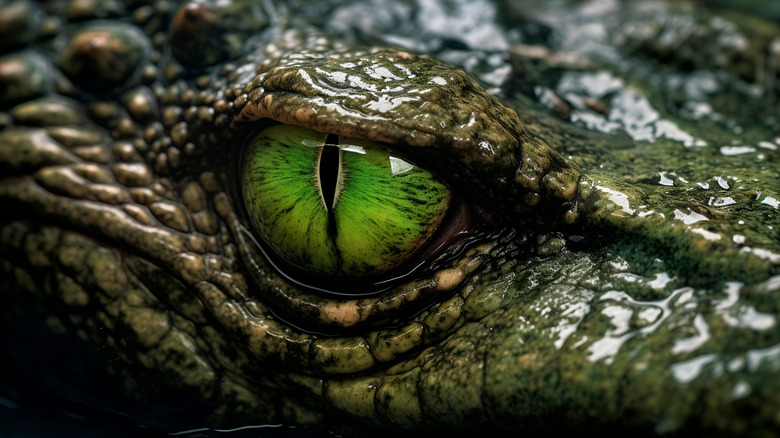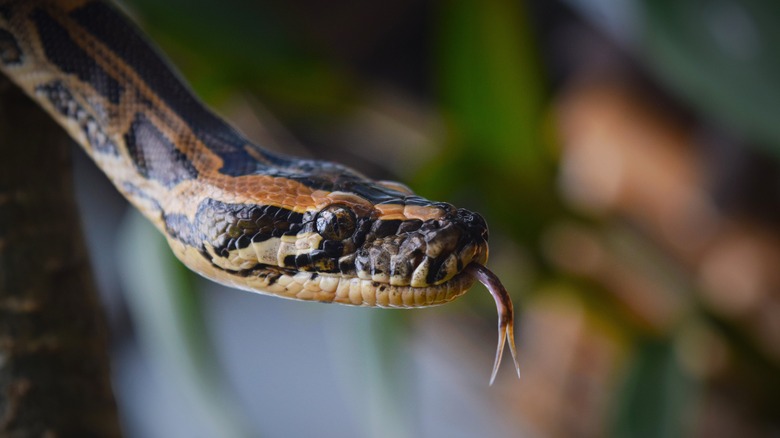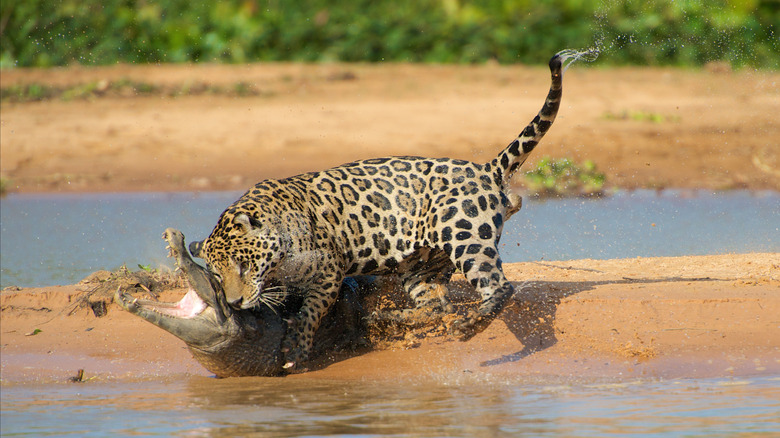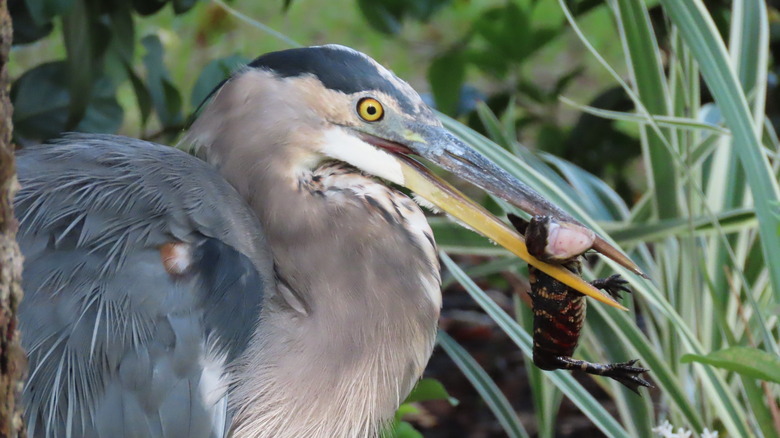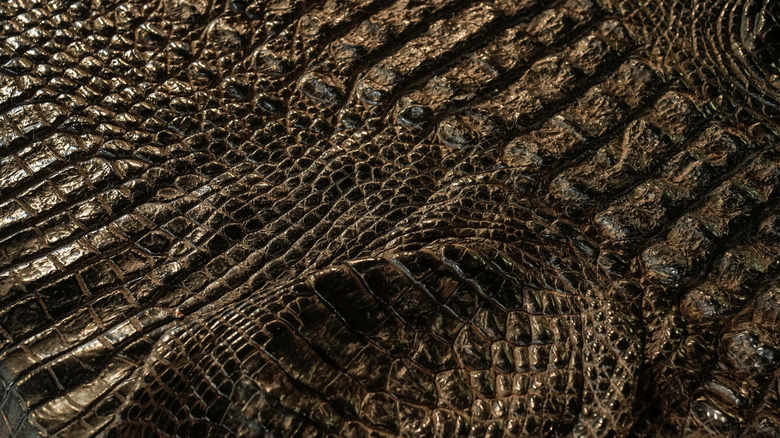4 Predators That Are Actually A Threat To Crocodiles And Alligators
Alligators and crocodiles are among the most formidable predators on the planet. These incredibly hardy animals have been around since the time of the dinosaurs, and may have even preyed on them. Any creature that can weather multiple mass extinction events, including the one that killed off the non-avian dinosaurs some 66 million years ago, is clearly tough. While alligators and crocodiles aren't quite as sturdy as nature's most indestructible organism, the tardigrade, they are uniquely resilient to the point it's amazing to think they have any predators at all to worry about.
The reptiles belong to the Crocodylia order, but crocodiles belong to the Crocodylidae family and alligators — as well as their close relatives, caimans — to the Alligatoridae family. Both are ectothermic, meaning they rely on external sources for heat, and have slow metabolisms, allowing them to endure periods of food scarcity and harsh temperatures. Alligators and crocodiles also have bony plates called osteoderms or scutes inside their skin, forming an outer armor that is very hard for any would-be predator to puncture. Add to that the fact that alligators and crocodiles are surprisingly fast, with the former boasting a top speed of 11mph and some crocodiles demonstrating a top speed of 20 mph, and you've got some of the most dangerous, resilient animals in existence.
What kind of predator, then, could possibly pose a threat to these hardy beasts? Well, quite a few as it turns out. Here's a rundown of predators that are actually a threat to crocodiles and alligators
Giant snakes
Believe it or not, snakes are one predator that alligators and crocodiles definitely have to worry about. Of course, this doesn't mean copperheads and rattlers are offing their fellow reptiles left and right, but giant snakes, like the Burmese pythons that share Florida with crocs and gaters, are a significant threat.
In 2022, a 5-foot alligator was removed from an 18-foot Burmese python during a necropsy on the snake, and this was far from an isolated incident, nor is it a recent phenomenon. The giant anaconda, for example, has been locked in a battle with crocodilians for millions of years. In the Pantanal — Earth's largest wetland stretching across Brazil and parts of Bolivia and Paraguay — smaller relatives to alligators called caimans are routinely killed and eaten by the colossal constrictor, which like the Burmese python, devours the incapacitated caiman whole. And in case you were running low on nightmare fuel, there was also the case of an Olive python which strangulated an Australian freshwater crocodile and swallowed the reptile whole back in 2019.
Big cats
It's not actually all that uncommon for big cats to feed on alligators and crocodiles. Take 6-year-old Bengal tigress Riddhi, who resides at Ranthambore National Park in Rajasthan, India, alongside her three cubs, all of whom have been observed to feast on crocodiles. Bengal tigers typically hunt deer, pigs, goats, and cattle, but when land-dwelling prey is in short supply, the tigers may prey on crocodiles.
Likewise, lions, typically known for preying on zebra and wildebeest, sometimes hunt crocodiles in certain parts of Africa. In Zimbabwe's Matusadona National Park and Kruger National Park in South Africa, conservation scientists have witnessed lions hunting crocs up to 12 feet long. Leopards are also known to hunt crocodiles, and have been observed dragging them up into trees to enjoy their meal.
Over in the Brazilian Pantanal, the Jofre Velho Conservation Ranch is home to jaguars who hunt the area's plentiful caimans. These big cats are adept at swimming and actually live semi-aquatic lifestyles, meaning they frequently come into contact with species such as the spectacled caiman and jacaré caiman in the region's numerous waterways. Jaguars are actually adapted to hunt neotropical reptiles such as the caiman, and it helps that they have the strongest bite (relative to their size) of any wild cat. The wild cat has also been recorded killing large crocodilians such as the Orinoco crocodile.
Large birds
While alligators and crocodiles can grow to gargantuan sizes, their early, more diminutive years are some of the most dangerous. In Florida, small young alligators are regularly killed and eaten by a variety of predators, such as raccoons, otters, and wading birds. In fact, wading birds can be pretty deadly predators for young crocodiles, and the great blue heron has been observed devouring small baby gators whole. The story gets even more grim, as nesting birds in the Florida everglades also sacrifice their own young to alligators, creating a macabre relationship between the two species.
Another wading bird, the shoebill stork, is also capable of swallowing young crocodiles whole. This imposing bird is found in the swamps of East Africa, where it mostly hunts fish and frogs, but will happily feast on water snakes, lizards, and baby crocodiles. Not only that, the shoebill stork sometimes fights fully grown Nile crocodiles in order to get to their young, making this one of the most surprisingly vicious and determined predators that crocodiles face in Africa.
Humankind
By far the biggest predator of crocodiles and alligators is, well, us. Humans pose the greatest threat to large alligators and crocodiles partly due to the fact their skin is a desirable commodity for the fashion industry, as well as that alligator numbers need to be managed.
In Florida alone, wildlife commission data (via Tampa Bay Times) documented the culling of 184,047 nuisance alligators between 1997 and 2021. While it might seem counterintuitive, this forms part of an effort to help conserve the gators' ecosystems, with states cooperating with the federal government to allow legal hunting of alligators in an attempt to keep their numbers in check. If left to their own devices, the alligator population would increase dramatically, mainly as a result of its apex predator status. Hunting, therefore, keeps alligator numbers from ballooning and other habitats safe from potentially dangerous gator incursions.
In Australia, human beings were so effective at hunting crocodiles that they nearly wiped the animal out there altogether. Back in the 1960s, wild saltwater crocodile numbers in the country's Northern Territory were down to around 5,000 due to commercial hunting. The crocs have since rebounded, with more than 100,000 present in the same area today, but it again demonstrates the ability of human beings to dominate these otherwise extremely sturdy and resilient predators. In Africa, meanwhile, crocodile skin is also a big commodity, and during the 1950s, 5 to 10 million Nile crocodiles were killed each year for their skin.
